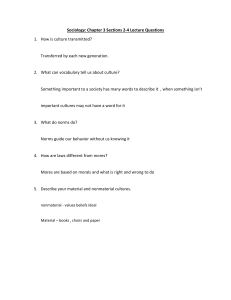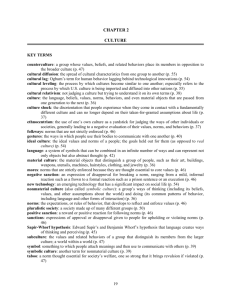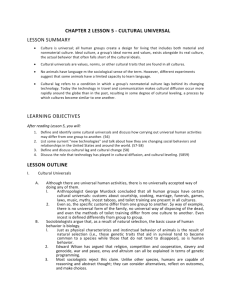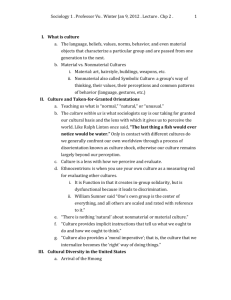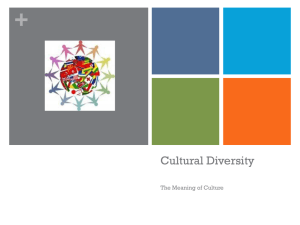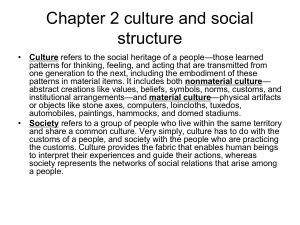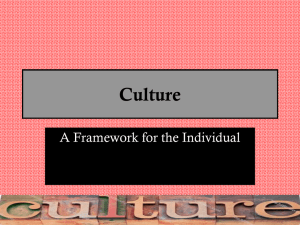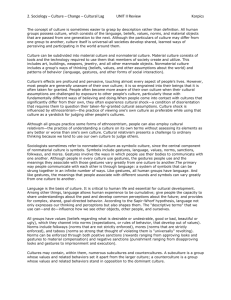Culture Worksheet: Sociology Concepts & Definitions
advertisement
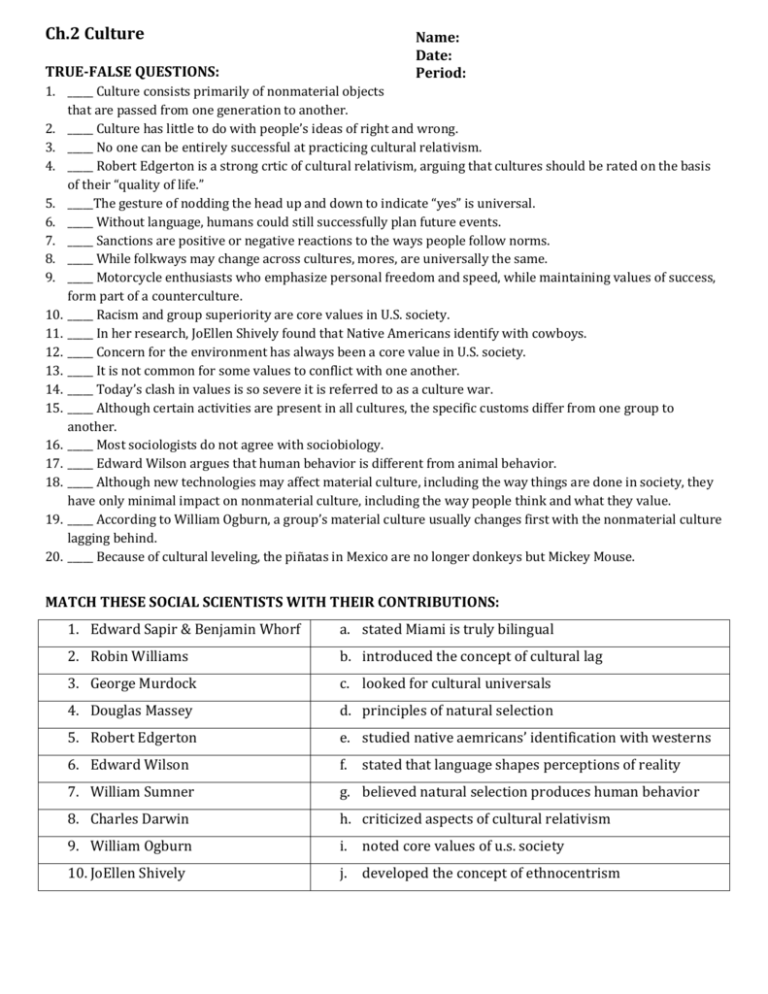
Ch.2 Culture Name: Date: Period: TRUE-FALSE QUESTIONS: 1. _____ Culture consists primarily of nonmaterial objects that are passed from one generation to another. 2. _____ Culture has little to do with people’s ideas of right and wrong. 3. _____ No one can be entirely successful at practicing cultural relativism. 4. _____ Robert Edgerton is a strong crtic of cultural relativism, arguing that cultures should be rated on the basis of their “quality of life.” 5. _____The gesture of nodding the head up and down to indicate “yes” is universal. 6. _____ Without language, humans could still successfully plan future events. 7. _____ Sanctions are positive or negative reactions to the ways people follow norms. 8. _____ While folkways may change across cultures, mores, are universally the same. 9. _____ Motorcycle enthusiasts who emphasize personal freedom and speed, while maintaining values of success, form part of a counterculture. 10. _____ Racism and group superiority are core values in U.S. society. 11. _____ In her research, JoEllen Shively found that Native Americans identify with cowboys. 12. _____ Concern for the environment has always been a core value in U.S. society. 13. _____ It is not common for some values to conflict with one another. 14. _____ Today’s clash in values is so severe it is referred to as a culture war. 15. _____ Although certain activities are present in all cultures, the specific customs differ from one group to another. 16. _____ Most sociologists do not agree with sociobiology. 17. _____ Edward Wilson argues that human behavior is different from animal behavior. 18. _____ Although new technologies may affect material culture, including the way things are done in society, they have only minimal impact on nonmaterial culture, including the way people think and what they value. 19. _____ According to William Ogburn, a group’s material culture usually changes first with the nonmaterial culture lagging behind. 20. _____ Because of cultural leveling, the piñatas in Mexico are no longer donkeys but Mickey Mouse. MATCH THESE SOCIAL SCIENTISTS WITH THEIR CONTRIBUTIONS: 1. Edward Sapir & Benjamin Whorf a. stated Miami is truly bilingual 2. Robin Williams b. introduced the concept of cultural lag 3. George Murdock c. looked for cultural universals 4. Douglas Massey d. principles of natural selection 5. Robert Edgerton e. studied native aemricans’ identification with westerns 6. Edward Wilson f. stated that language shapes perceptions of reality 7. William Sumner g. believed natural selection produces human behavior 8. Charles Darwin h. criticized aspects of cultural relativism 9. William Ogburn i. noted core values of u.s. society 10. JoEllen Shively j. developed the concept of ethnocentrism Ch.2 Culture Name: Date: Period: FILL-IN-THE-BLANK QUESTIONS: 1. The material objects that distinguish a group of people, such as their art, building weapons, utensils, machines, hairstyles, clothing, and jewelry are known as __________. 2. When Sue experiences disorientation from moving from the U.S. to Africa, this is known as _________. 3. Trying to understand a culture on its own terms is the concept of __________. 4. A __________ is something to which people attach meaning and then use to communicate with others. 5. __________ are ways in which people use their body to communicate with one another. 6. The Sapir-Whorf hypothesis says __________ has embedded in it ways of looking at the world. 7. Expectations, or rules of behavior, that develop out of a group’s values, are __________. 8. Norms, that are not strictly enforced, are __________. 9. __________ groups have values and norms that place it in opposition to the dominant culture. 10. __________ are a series of interrelated values that together form a larger whole. 11. Leisure time is becoming an emerging __________. 12. Sociologists call the norms and values that people actually follow __________. 13. Emerging technologies that have a significant impact on social life are referred to as __________. 14. William Ogburn used the term _________ to refer to a situation in which nonmaterial culture takes a period of time to adjust to changes in the material culture. 15. The process in which cultures become similar to one another is __________. 1. 6. 11. 2. 7. 12. 3. 8. 13. 4. 9. 14. 5. 10. 15.
